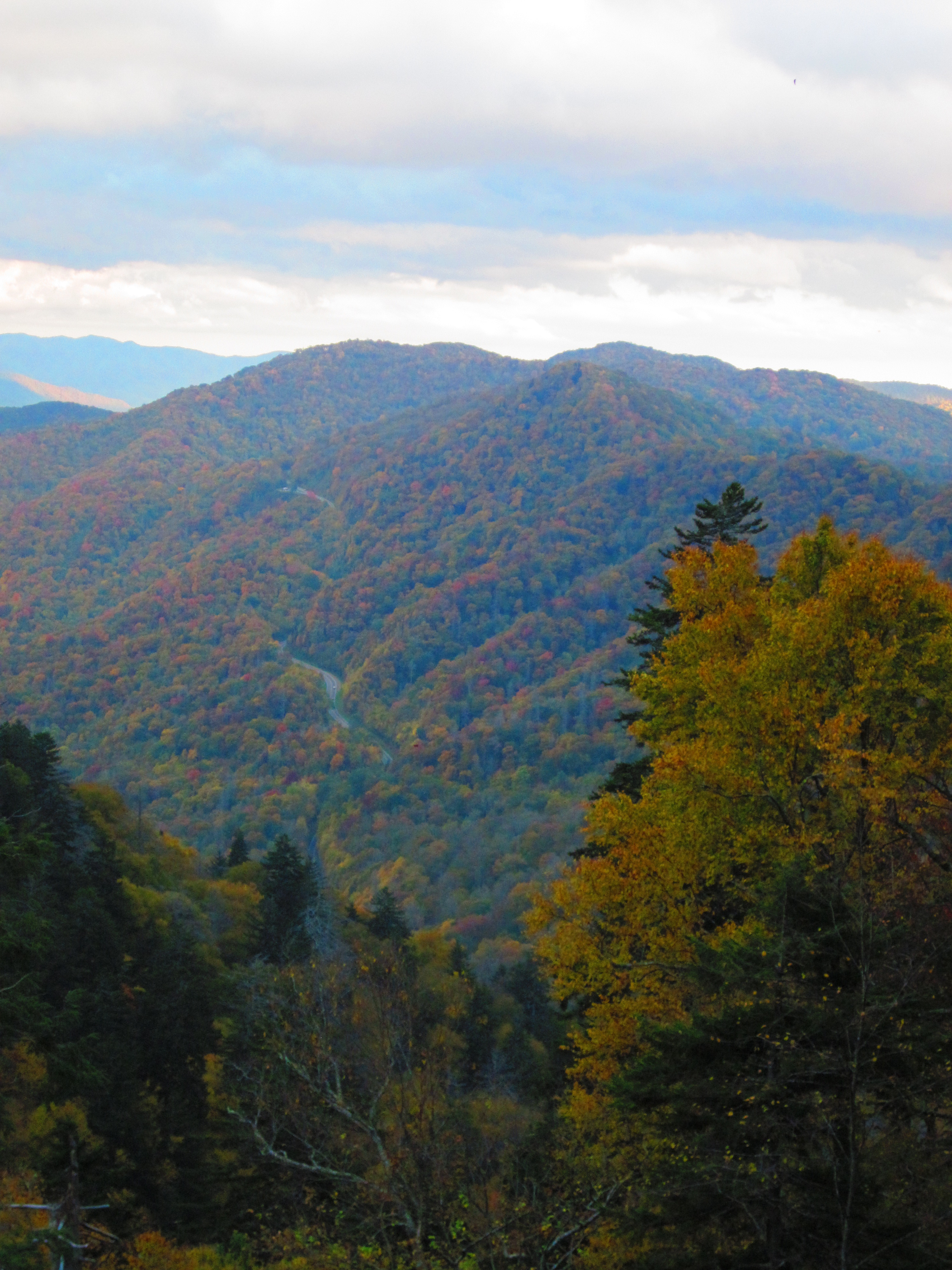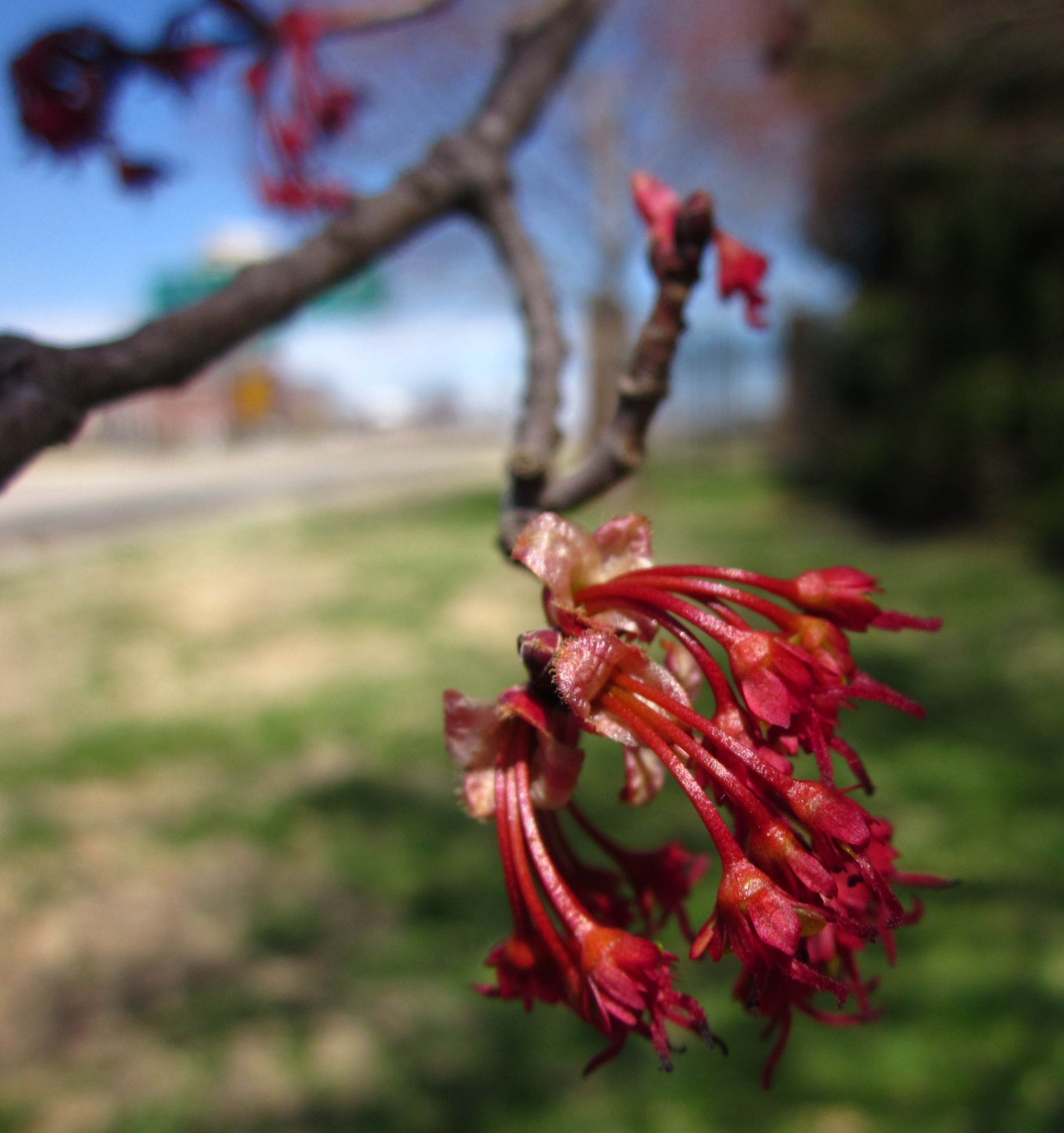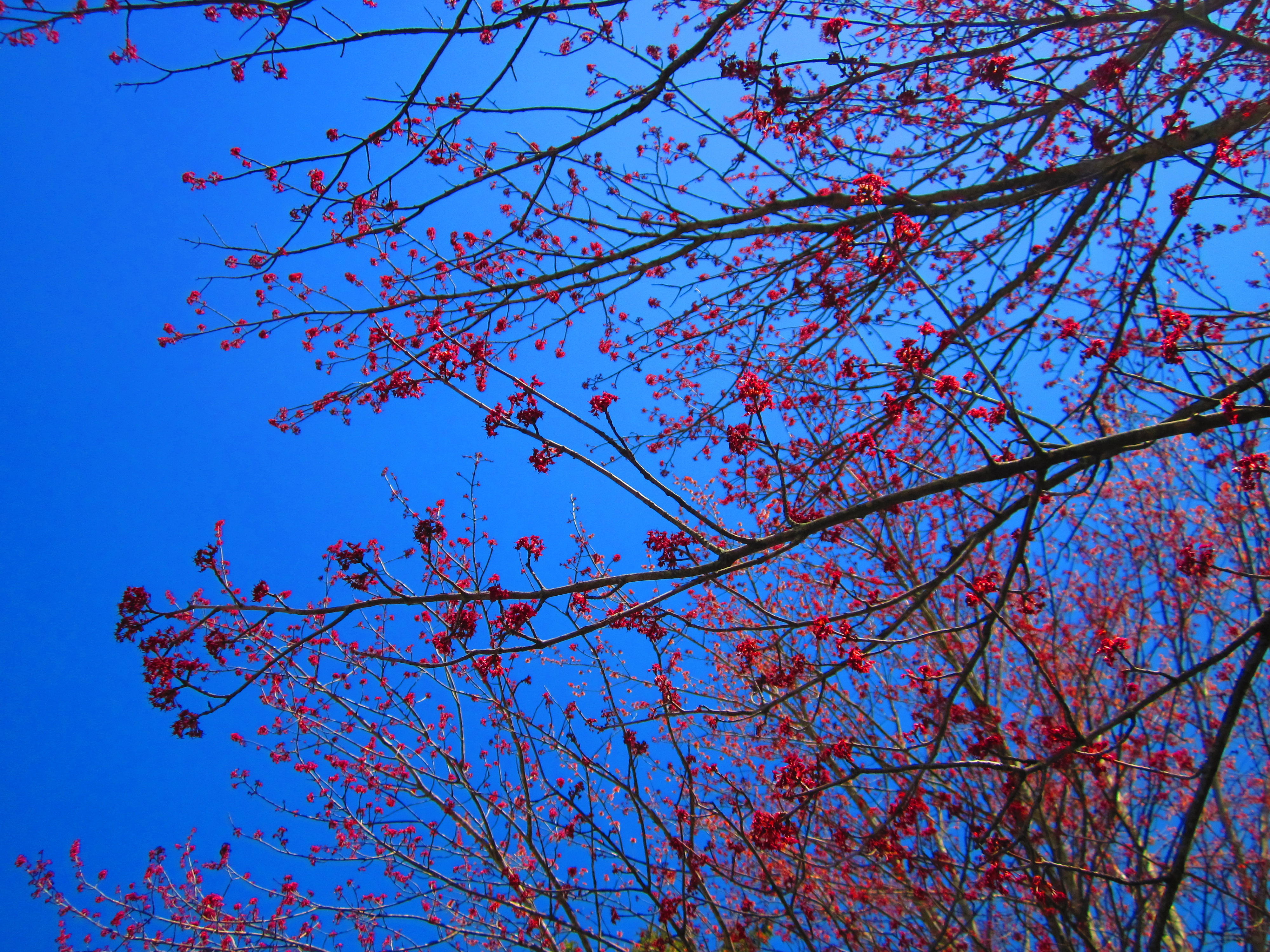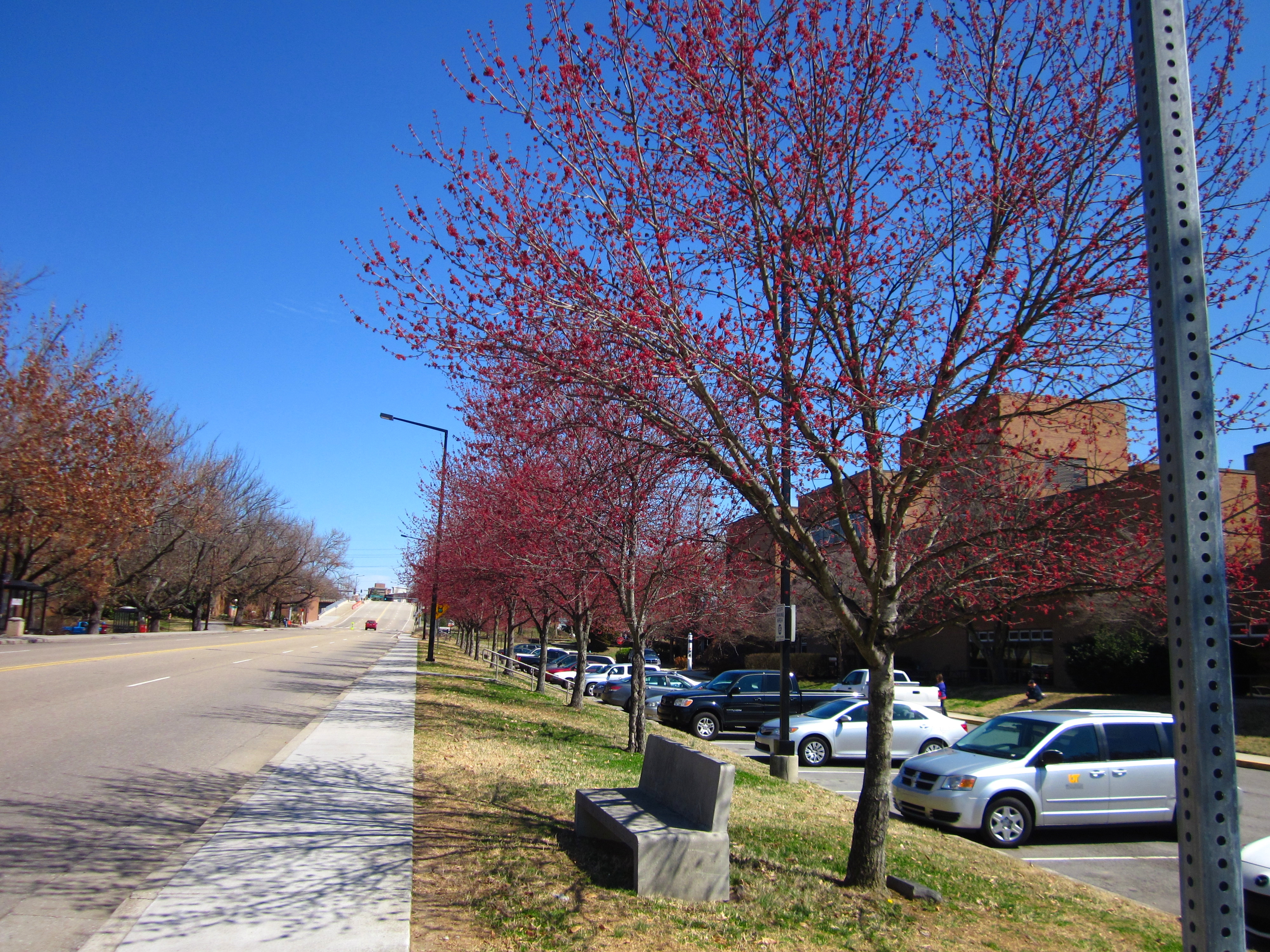 | |
| Native maples in their fall glory in GSMNP. In addition to their fall foliage, maples should be valued for their early spring blooms. |
I love spring! Signs of life, like buds forming on a tree or sprays
of flowers pushing from the cold soil, make me think of the earth
yawning, stretching, and rubbing the sleep from its eyes, ready to wake
up for another season of growth. One of my favorite signs of spring is
when our native maples (Acer rubrum, A. saccharum, A. saccharinum) begin to bloom.
When many of us think of maples, our minds probably go straight to their spectacular fall foliage. This is why most of the North American maples in the nursery industry are bred for their autumn color. Their delicate spring blossoms are often overlooked, but en masse maples in flower can be real show stoppers.
My favorite way to view maples in their spring glory is by taking a long, Sunday drive on a back road. Last weekend we drove down Route 441 from Townsend, Tennessee to Lake City, Florida. The whole way down our native maples painted the roadside with sunny limes, yellows, peachy pinks, and bold scarlet reds. Over the next month, whole mountain sides in the Great Smoky Mountains National Park will be dotted with the colors of maples in bloom.
Some specimens produce bolder, showier blooms
than others. Maples can bloom as early as January or as late as
April. Flowering in maples is both a response to environmental
conditions and a function of genetic predisposition. Genetic variation
is responsible for inconsistency in blooming, which causes stands of
maples in the wild to produce a smattering of blooms throughout the
spring. Although nursery breeders seek to control the genetic qualities
of the maples they produce, flower time and quality is often an
afterthought. This means that maple flowering in the landscape can be
just as inconsistent between two plants as in the wild.
Unlike
other spring flowering trees that are pollinated by bees and other
insects (such as cherries, dogwoods, and redbuds) maples are wind pollinated. The earlier maples are able to blossom, the fewer barriers
there will be to pollination. For example, if a maple flowers in
January, none of the other trees or shrubs have leafed out yet, so the
pollen can travel unhindered from one flower to another. This can be a
risky move, because a cold snap can damage flowers and samara
development. On the other hand, if a maple flowers in April there will
be less danger of cold damage. However, many other trees in the
landscape may already have foliage, preventing how effectively wind can
carry the pollen between flowers.
Those who want to enjoy the spring blossoms of maples in the comfort of their own landscape may be in for disappointment. As stated earlier, the industry doesn't currently breed maples for flower quality. Strong, handsome maples that provide beauty, shade, and vibrant fall color may also produce lackluster blooms. However, there are a few things you can do to improve your odds of finding a maple that will add stunning spring blooms to your landscape:
Thank you to Garden Talk on Knox Talk 94.3 FM for inviting me on to present their plant of the week this morning! If you're wondering, the featured plant was Acer rubrum. To read more of my favorite plants, be sure to follow me on Plante on Plants. To tune in to more gab from the garden gurus, stream Garden Talk live online on the Knox Talk website.
If you have any questions, ideas or suggestions, please feel welcome to post a comment below or to send me an email.
What are some plants that shout SPRING to you? What's your experience with our native maples? What are some other overlooked spring bloomers?
When many of us think of maples, our minds probably go straight to their spectacular fall foliage. This is why most of the North American maples in the nursery industry are bred for their autumn color. Their delicate spring blossoms are often overlooked, but en masse maples in flower can be real show stoppers.
My favorite way to view maples in their spring glory is by taking a long, Sunday drive on a back road. Last weekend we drove down Route 441 from Townsend, Tennessee to Lake City, Florida. The whole way down our native maples painted the roadside with sunny limes, yellows, peachy pinks, and bold scarlet reds. Over the next month, whole mountain sides in the Great Smoky Mountains National Park will be dotted with the colors of maples in bloom.
 |
| A cluster of maple inflorescences |
 | |
| When in flower, our North American native maples can be just as showy as many of the more familiar spring blooming trees |
Those who want to enjoy the spring blossoms of maples in the comfort of their own landscape may be in for disappointment. As stated earlier, the industry doesn't currently breed maples for flower quality. Strong, handsome maples that provide beauty, shade, and vibrant fall color may also produce lackluster blooms. However, there are a few things you can do to improve your odds of finding a maple that will add stunning spring blooms to your landscape:
- Consider a red maple (Acer rubrum) - Red maples purchased from a reputable nursery don't just produce red fall foliage (although many may also have yellow, green, and orange fall color). Red maples tend to also generate scarlet inflorescences. To quote Dr. Michael Dirr in his Manual of Woody Landscape Plants (1998), A. rubrum's "red, rarely yellowish" spring blooms may be composed of mostly pistils, stamins, or they may be monoecous, but "all are showy".
- Buy local - This tip doesn't just mean you should support your local garden centers (which is always a good thing to do!). Maples grown in your area are more likely to perform well in the long term and endure in the landscape than maples grown in another region of the country. This is especially true for folks up north -- although maples grown in the south may be the same species as the maples native to your area, they typically aren't as cold hardy.
- Avoid grafts? - If you're looking for a Japanese maple (A. palmatum), a graft is a must. However, there are mixed reviews of how grafted red maples perform in the long run. Dirr (1998) noted that grafted native maples tend to not perform as well long-term as maples grown from cuttings, tissue culture, or seed. Remember, seed-grown plants may last longer than a maple grown from a graft, but with the genetic variation of seed-grown plants you never know what you're going to get. On the other hand, Matt Nichols of Mr. Maple has successfully grafted red maples and has grafted sugar maples. It would be a good idea to do some investigating and buy from a quality nursery.
Thank you to Garden Talk on Knox Talk 94.3 FM for inviting me on to present their plant of the week this morning! If you're wondering, the featured plant was Acer rubrum. To read more of my favorite plants, be sure to follow me on Plante on Plants. To tune in to more gab from the garden gurus, stream Garden Talk live online on the Knox Talk website.
If you have any questions, ideas or suggestions, please feel welcome to post a comment below or to send me an email.
What are some plants that shout SPRING to you? What's your experience with our native maples? What are some other overlooked spring bloomers?
 |
| The delicate flower buds of Acer rubrum |
 |
| Acer rubrum in bloom |
 |
| A hybrid maple, Acer x freemanii, makes an attractive street tree on the University of Tennessee's Agriculture campus. |